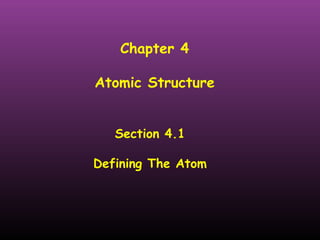This document discusses the structure of atoms. It begins by defining an atom and outlining Dalton's atomic theory. It then explains that atoms are composed of subatomic particles like electrons, protons, and neutrons. The nucleus contains protons and neutrons, while electrons orbit around the nucleus. Different elements are distinguished by their atomic number, which is the number of protons. Isotopes are atoms that have the same number of protons but different numbers of neutrons. The average atomic mass takes into account the relative abundances of isotopes in a naturally occurring sample of an element.









